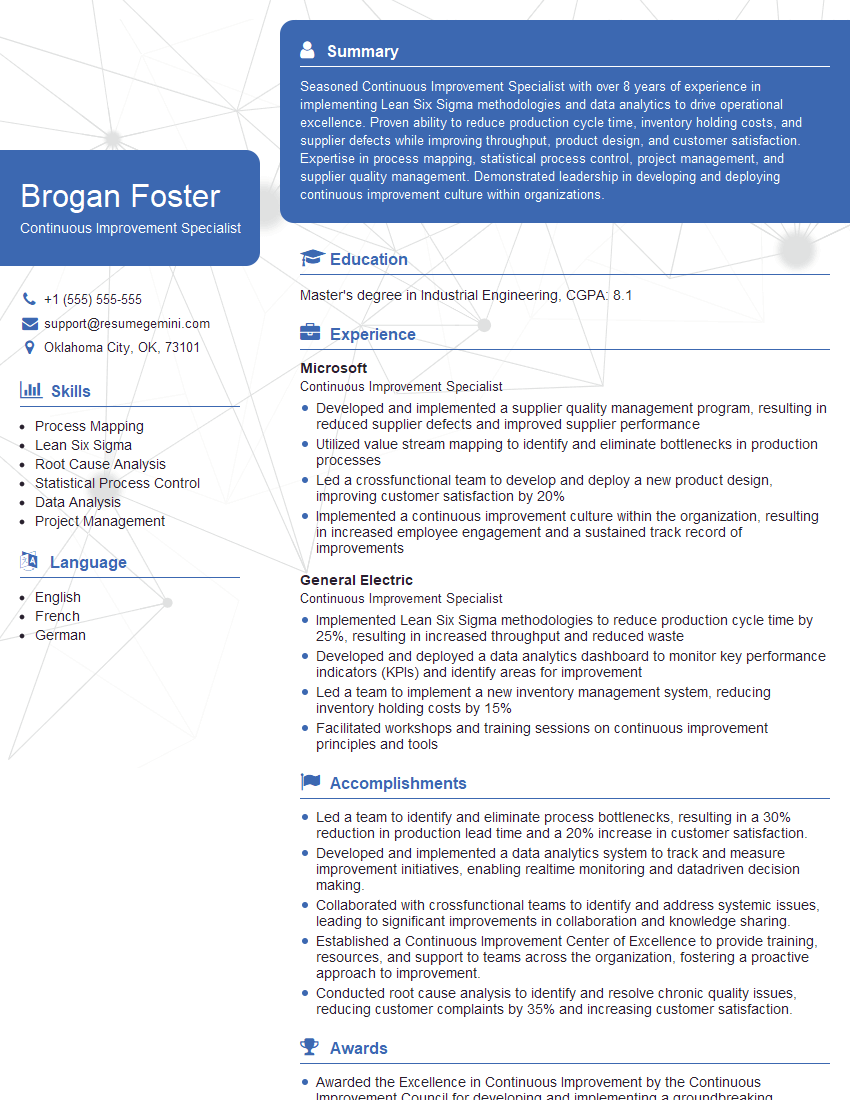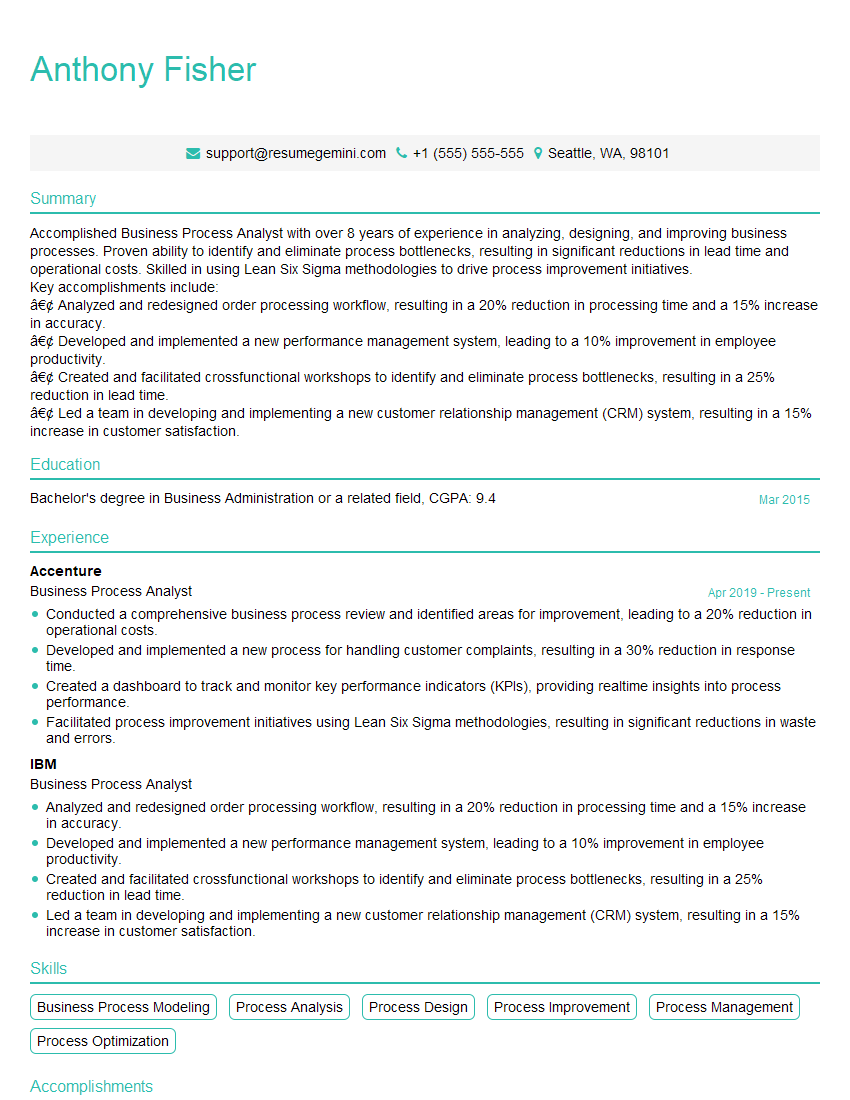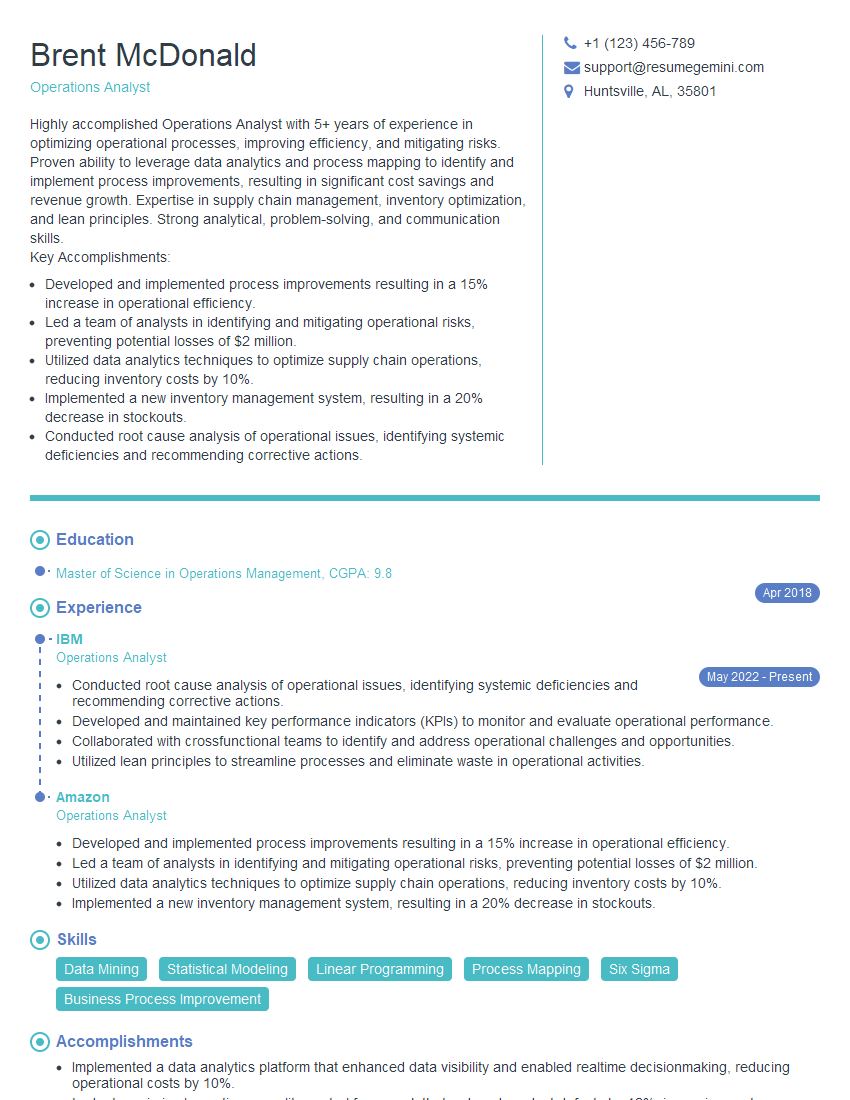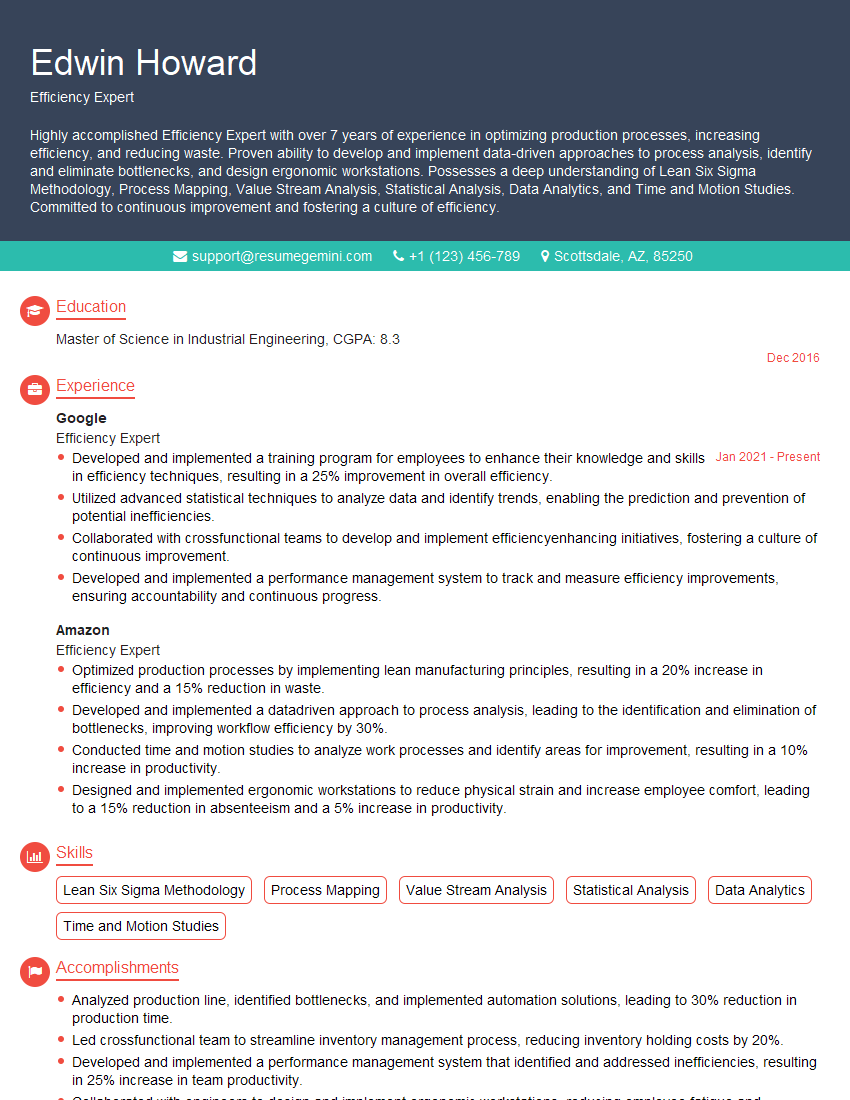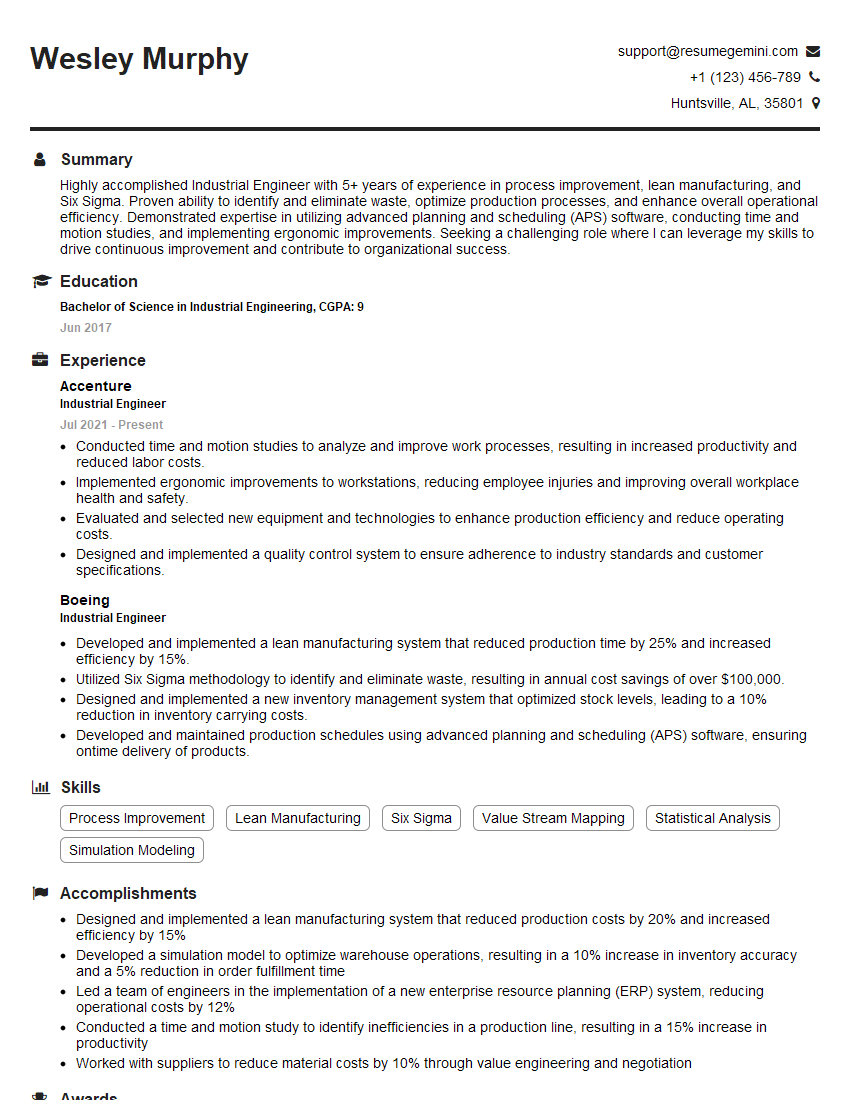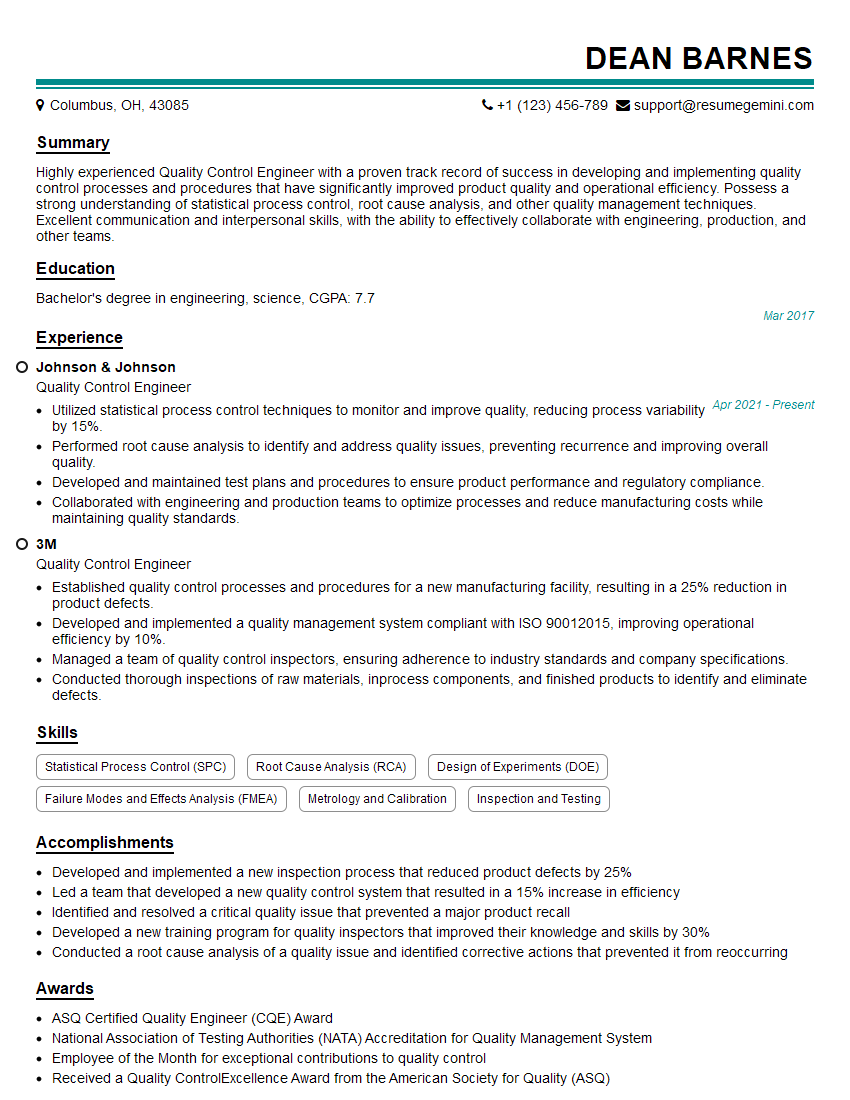Interviews are more than just a Q&A session—they’re a chance to prove your worth. This blog dives into essential Kaizen/Continuous Improvement interview questions and expert tips to help you align your answers with what hiring managers are looking for. Start preparing to shine!
Questions Asked in Kaizen/Continuous Improvement Interview
Q 1. Explain the principles of Kaizen.
Kaizen, meaning ‘change for the better’ in Japanese, is a philosophy focused on continuous improvement. It’s not about revolutionary changes, but rather incremental, ongoing improvements involving everyone in an organization. Its core principles revolve around:
- Continuous Improvement: The belief that improvement is an ongoing process, not a one-time event. Small changes, implemented consistently, lead to significant results over time.
- Employee Empowerment: Encouraging every employee to identify and suggest improvements, regardless of their role. This fosters a culture of ownership and innovation.
- Customer Focus: Understanding and meeting customer needs is central to Kaizen. Improvements should always aim to enhance customer satisfaction.
- Waste Reduction: Identifying and eliminating all forms of waste (muda) in processes, including overproduction, waiting, transportation, unnecessary processing, inventory, motion, and defects. This is often visualized through a tool called a Value Stream Map.
- Process Improvement: Focus on streamlining and optimizing workflows to enhance efficiency and quality. This often involves simplifying processes, removing bottlenecks, and improving communication.
Imagine a manufacturing plant constantly tweaking its assembly line to reduce downtime and improve product quality – that’s Kaizen in action. Or a software team that regularly refactors code and implements user feedback to enhance the user experience. It’s a proactive, ingrained way of working.
Q 2. Describe the PDCA cycle (Plan-Do-Check-Act).
The PDCA cycle (Plan-Do-Check-Act) is a four-step iterative process for problem-solving and improvement. It’s a cornerstone of Kaizen and many other quality management methodologies:
- Plan: Define the problem, set goals, and develop a plan to address the issue. This involves data gathering, analysis, and identifying potential solutions.
- Do: Implement the planned changes on a small scale (pilot test). This allows for testing and evaluation without widespread disruption.
- Check: Monitor the results of the implemented changes. Collect data to assess whether the goals were met and identify any unexpected consequences.
- Act: Standardize successful changes and implement them on a larger scale. If the changes didn’t work, analyze the results, learn from mistakes, and revise the plan for another iteration of the PDCA cycle.
For example, imagine a customer service team experiencing high call wait times. The Plan phase might involve analyzing call volume, identifying bottlenecks, and proposing solutions like additional staffing or improved call routing. The Do phase could be a trial run of the new staffing schedule or routing system. The Check phase would involve monitoring wait times during the trial. Finally, the Act phase would involve implementing the solution permanently or refining it based on the trial results. This cyclical approach ensures continuous refinement and improvement.
Q 3. What are the 5S methodologies and how are they implemented?
The 5S methodology is a workplace organization method that creates a visual workplace conducive to efficiency and safety. It’s a foundational step in many Kaizen initiatives. The five S’s are:
- Seiri (Sort): Eliminate unnecessary items from the workspace. Only keep what is essential for the job. This involves discarding, donating, or relocating items that aren’t needed.
- Seiton (Set in Order): Organize the remaining items for easy access and use. This includes clear labeling, efficient storage, and logical arrangement of tools and materials.
- Seiso (Shine): Clean the workplace thoroughly. This involves regular cleaning and maintenance to prevent dirt buildup and identify potential problems early on.
- Seiketsu (Standardize): Establish procedures to maintain the organized and clean workplace. This involves creating checklists, implementing regular inspections, and training staff to maintain the 5S standards.
- Shitsuke (Sustain): Maintain the improvements through consistent effort and discipline. This involves regular reviews, continuous improvement efforts, and embedding 5S into the workplace culture.
Imagine a cluttered office. Seiri involves removing unnecessary files and supplies. Seiton means organizing the remaining items into labeled folders and drawers. Seiso is the daily cleaning. Seiketsu is establishing a cleaning schedule. Shitsuke is the ongoing commitment to keeping the office organized and clean.
Q 4. Explain the concept of Value Stream Mapping.
Value Stream Mapping (VSM) is a lean manufacturing technique used to visualize the flow of materials and information involved in bringing a product or service to the customer. It helps identify areas of waste and bottlenecks in a process. A VSM typically includes:
- Process Steps: A visual representation of each step involved in the process.
- Data Points: Quantifiable data such as processing times, inventory levels, and transportation times.
- Waste Identification: Highlighting areas where waste exists (muda).
- Future State Map: A depiction of how the process could look after improvements are implemented.
Imagine creating a VSM for an order fulfillment process. You’d map out each step from order placement to delivery, noting the time spent at each step, the inventory levels, and the movement of goods. This visualization would reveal bottlenecks, like excessive waiting times or inefficient transportation, paving the way for targeted improvements.
Q 5. How do you identify and prioritize improvement opportunities?
Identifying and prioritizing improvement opportunities requires a systematic approach. I typically use a combination of methods:
- Data Analysis: Analyzing process data (e.g., defect rates, cycle times, customer complaints) to identify areas needing attention. Tools like Pareto charts and control charts are useful here.
- Process Observation: Observing processes firsthand to identify bottlenecks, inefficiencies, and safety hazards. Gemba walks (going to the actual place where the work is done) are crucial.
- Employee Input: Gathering suggestions and feedback from employees through brainstorming sessions, suggestion boxes, or surveys. Employees often have valuable insights into process improvements.
- Customer Feedback: Analyzing customer feedback to understand their needs and identify areas where the product or service can be improved.
- Prioritization Matrices: Using matrices like a Prioritization Matrix (Impact vs. Effort) to rank opportunities based on their potential impact and the effort required to implement them. High-impact, low-effort opportunities should be prioritized.
For example, if defect rates are high, data analysis would point towards the cause. Employee input might reveal challenges in the process that data alone might miss. A prioritization matrix then helps decide which improvement to tackle first based on its impact and feasibility.
Q 6. Describe your experience with root cause analysis.
Root cause analysis is crucial for effective Kaizen. I have extensive experience using various techniques, including:
- 5 Whys: Repeatedly asking ‘why’ to drill down to the root cause of a problem. This simple yet effective technique helps uncover underlying issues often hidden beneath surface symptoms.
- Fishbone Diagram (Ishikawa Diagram): A visual tool used to brainstorm potential causes of a problem, categorized by factors like people, methods, materials, machines, environment, and measurement.
- Fault Tree Analysis: A top-down approach that visually represents the logical relationships between potential causes and the resulting failure. This is useful for complex problems.
In a previous project, a manufacturing line experienced frequent equipment failures. Using the 5 Whys, we discovered the root cause wasn’t a faulty machine but inadequate maintenance procedures. This insight allowed us to focus on training and preventative maintenance rather than replacing expensive equipment.
Q 7. What are some common Kaizen tools and techniques?
Many tools and techniques support Kaizen initiatives. Some of the most common include:
- Pareto Chart: A bar graph illustrating the frequency of various causes, helping prioritize issues.
- Control Chart: Used to monitor process stability and identify potential deviations.
- Value Stream Map: Visualizes the flow of materials and information to identify waste.
- Fishbone Diagram (Ishikawa Diagram): Brainstorms potential causes of problems.
- 5 Whys: A root cause analysis technique.
- Kanban: A visual system for managing workflow.
- Poka-Yoke (Mistake-Proofing): Designing processes to prevent errors.
The choice of tool depends on the specific problem and context. A Pareto chart might help prioritize customer complaints, while a Value Stream Map would be useful for analyzing a manufacturing process. The key is to select the right tools to effectively analyze data and visualize improvements.
Q 8. How do you measure the success of a Kaizen project?
Measuring the success of a Kaizen project goes beyond simply achieving a target. It requires a multi-faceted approach, focusing on both quantitative and qualitative results. We need to define Key Performance Indicators (KPIs) before starting the project to ensure we’re measuring the right things. These KPIs should directly reflect the problem the Kaizen project aims to solve.
- Quantitative Metrics: These are easily measurable data points. For example, if the project aims to reduce production defects, we’d track the defect rate before and after implementation. Other examples include cycle time reduction, improved throughput, cost savings, and increased efficiency (measured as output per unit of input).
- Qualitative Metrics: These assess the less tangible aspects. Did employee morale improve? Did the process become safer? Was the implementation easy to understand and follow? We can gather this data through surveys, interviews, and observations.
It’s crucial to establish a baseline before the project begins to provide a benchmark for comparison. Regular monitoring throughout the project allows for early detection of any issues and provides valuable data for ongoing improvement. Finally, post-implementation monitoring is essential to ensure the gains are sustained.
Example: In a previous project aimed at reducing customer service call handling time, we tracked the average call duration, customer satisfaction scores (CSAT), and agent feedback. The quantitative data showed a 15% reduction in average call duration, while the qualitative data confirmed improved agent morale and higher CSAT scores, demonstrating the overall success of the Kaizen initiative.
Q 9. How do you handle resistance to change during a Kaizen implementation?
Resistance to change is a common hurdle in Kaizen implementations. Addressing it requires empathy, clear communication, and a participative approach. It’s vital to understand why people are resistant – fear of the unknown, loss of control, or perceived extra workload are common reasons.
- Communication is key: Clearly explain the rationale behind the changes, highlighting the benefits for individuals and the organization as a whole. Involve employees in the process, fostering a sense of ownership and buy-in.
- Address concerns directly: Actively listen to employees’ concerns and address them openly and honestly. Provide training and support to address anxieties about new skills or processes.
- Pilot testing: Implement the Kaizen initiative on a smaller scale initially, allowing for adjustments based on feedback before a full-scale rollout. This reduces the risk and allows for a smoother transition.
- Celebrate successes: Acknowledge and celebrate early wins, reinforcing positive behavior and encouraging continued participation.
- Leadership support: Ensure that leadership actively champions the change, demonstrating their commitment and providing the necessary resources.
Example: In a previous project involving a change in workflow, we held several brainstorming sessions with the team to gather input and address their concerns. We then piloted the new workflow with a small group, making adjustments based on their feedback before implementing it organization-wide. This collaborative approach significantly minimized resistance.
Q 10. Explain your experience with data analysis in Kaizen projects.
Data analysis is the backbone of effective Kaizen. It’s not just about collecting data; it’s about using it to identify problems, track progress, and make data-driven decisions. My experience involves using a variety of tools and techniques to analyze data from various sources.
- Data Collection: I utilize various methods, including process mapping, time studies, defect tracking, and surveys to gather relevant data. The selection depends on the specific Kaizen project and its objectives.
- Data Analysis Techniques: I am proficient in using statistical tools like control charts (e.g., Shewhart, CUSUM), Pareto charts, histograms, and scatter plots to identify trends, patterns, and root causes of problems. I also utilize spreadsheet software (Excel, Google Sheets) and statistical software packages (e.g., Minitab, R) for more advanced analysis.
- Data Visualization: I believe in presenting data in a clear and concise manner using charts and graphs, making it easily understandable to all stakeholders. This enables effective communication of findings and facilitates data-driven decision-making.
Example: In a manufacturing setting, we used control charts to monitor the defect rate of a particular product. By analyzing the data, we identified a period of increased defects, leading to an investigation that revealed a faulty machine part as the root cause. This allowed us to address the problem promptly, preventing further defects and improving product quality.
Q 11. Describe a time you successfully implemented a Kaizen initiative.
In a previous role, we faced significant delays in order fulfillment due to inefficiencies in the warehouse picking process. To tackle this, we launched a Kaizen project focusing on optimizing the warehouse layout and picking procedures.
- Problem Definition: We clearly defined the problem – long order fulfillment times leading to customer dissatisfaction and increased operational costs.
- Data Collection: We mapped the current picking process, measured cycle times, and analyzed order data to identify bottlenecks.
- Kaizen Implementation: Based on our analysis, we implemented several changes, including reorganizing the warehouse layout to optimize product placement, introducing a new picking system, and implementing visual management tools.
- Results: The changes resulted in a 25% reduction in order fulfillment time, a 10% decrease in picking errors, and improved employee morale due to increased efficiency and reduced physical strain.
The key to success was the team’s active participation throughout the process. We empowered employees to identify and propose solutions, fostering a sense of ownership and commitment. This collaborative approach ensured that the improvements were sustainable and effectively addressed the underlying challenges.
Q 12. What are the key differences between Lean and Six Sigma?
While both Lean and Six Sigma aim for process improvement, they differ in their approaches and focus.
- Lean: Focuses on eliminating waste (muda) in all forms – overproduction, waiting, transportation, over-processing, inventory, motion, and defects. It emphasizes streamlining processes, improving flow, and reducing variability. Lean often uses visual management and employs tools like value stream mapping and 5S.
- Six Sigma: Focuses on reducing variation and defects in processes to achieve near-perfection (six standard deviations from the mean). It uses statistical methods to identify and eliminate root causes of defects. Six Sigma commonly employs DMAIC (Define, Measure, Analyze, Improve, Control) methodology.
Key Differences Summarized:
Lean emphasizes speed and flow, while Six Sigma emphasizes precision and reduction of variation. Lean is often more holistic, focusing on the entire value stream, whereas Six Sigma tends to focus on specific processes or projects. Both are powerful methodologies, and they can be used together synergistically.
Q 13. How do you ensure sustainability of Kaizen improvements?
Sustainability of Kaizen improvements requires a systematic approach that goes beyond the initial implementation. It’s about embedding the improvements into the organizational culture and ensuring continuous monitoring and refinement.
- Standardization: Document the improved processes and create standard operating procedures (SOPs) to ensure consistency. This makes it easier for new employees to understand and follow the improved procedures.
- Training and Communication: Provide comprehensive training to employees on the new processes and continue to communicate the importance of the improvements. Regular training refreshes knowledge and reinforces best practices.
- Monitoring and Measurement: Continuously monitor the KPIs to track progress and identify any deviations from the expected results. Regular review meetings help to keep the improvements at the forefront.
- Feedback Mechanisms: Establish feedback mechanisms to capture employee suggestions and concerns. This ensures that the improvements remain relevant and continue to meet the changing needs of the organization.
- Leadership Support: Continued leadership support is crucial for maintaining momentum and providing the necessary resources for sustaining the improvements. Leadership must champion the ongoing improvement.
Example: After implementing a Kaizen project, we created a standard operating procedure document and conducted regular training sessions for all employees. We also established a monthly review meeting to monitor KPIs and gather feedback, ensuring the improvements remained effective and relevant over time.
Q 14. What is your experience with visual management?
Visual management is a cornerstone of effective Kaizen. It makes information readily available and easily understandable to everyone involved in the process. This promotes better communication, faster problem-solving, and increased accountability.
- Tools and Techniques: I have experience implementing various visual management tools, including Kanban boards, Andon systems (visual signaling of problems), 5S methodologies (Sort, Set in Order, Shine, Standardize, Sustain), value stream maps, and dashboards displaying key performance indicators (KPIs).
- Practical Applications: I’ve used visual management in various settings, from manufacturing floors to office environments. For example, we implemented a Kanban system in a software development team to visualize the workflow, identify bottlenecks, and improve team collaboration.
- Benefits: Visual management improves communication, enhances problem identification and resolution, increases team accountability, and promotes a culture of continuous improvement.
Example: In a previous project, we used a Kanban board to manage tasks in a software development project. The visual representation of the workflow enabled the team to quickly identify bottlenecks and prioritize tasks, resulting in faster project completion and improved team productivity. The board also acted as a constant reminder of priorities and progress.
Q 15. How do you involve employees in Kaizen projects?
Employee involvement is paramount to Kaizen’s success. It’s not about management imposing changes, but about empowering the workforce to identify and solve problems. I approach this through several strategies:
- Suggestion Schemes: Formal systems for employees to submit improvement ideas, with clear processes for review and implementation. This fosters a culture of continuous contribution.
- Cross-Functional Teams: Creating diverse teams including individuals from various departments and levels ensures varied perspectives and broader ownership of solutions.
- Training and Empowerment: Providing employees with Kaizen tools and techniques training (e.g., process mapping, root cause analysis) enhances their ability to contribute effectively. This also builds confidence and a sense of ownership.
- Recognition and Rewards: Acknowledging and rewarding employees for their contributions, no matter how small, reinforces positive behavior and encourages continued participation. This could include things like public praise, small bonuses, or even simply featuring their ideas in company newsletters.
- Regular Communication: Keeping employees informed about the progress of Kaizen projects and the impact of their contributions is crucial. This builds trust and keeps them engaged.
For example, in a previous role, we implemented a suggestion scheme that resulted in a 15% reduction in production errors within six months, directly attributed to the insightful suggestions from frontline workers.
Career Expert Tips:
- Ace those interviews! Prepare effectively by reviewing the Top 50 Most Common Interview Questions on ResumeGemini.
- Navigate your job search with confidence! Explore a wide range of Career Tips on ResumeGemini. Learn about common challenges and recommendations to overcome them.
- Craft the perfect resume! Master the Art of Resume Writing with ResumeGemini’s guide. Showcase your unique qualifications and achievements effectively.
- Don’t miss out on holiday savings! Build your dream resume with ResumeGemini’s ATS optimized templates.
Q 16. Describe your understanding of Gemba walks.
Gemba walks are structured observations conducted at the actual place of work (‘Gemba’ in Japanese). It’s not simply a walk-through; it’s a focused, systematic approach to understand the process firsthand. I see it as a crucial tool for gaining real-time insights and validating assumptions.
During a Gemba walk, I focus on:
- Observation: Carefully observing the workflow, identifying bottlenecks, and noting any inefficiencies or safety hazards.
- Data Collection: Gathering quantitative data (e.g., cycle times, defect rates) to support observations.
- Interaction: Engaging with employees on the Gemba to understand their perspectives, challenges, and suggestions. This is vital for uncovering hidden problems and understanding the root causes.
- Visual Management: Assessing the effectiveness of visual controls (e.g., Kanban boards, 5S implementation) in optimizing workflow and communication.
For instance, during a Gemba walk at a manufacturing plant, I observed a significant delay in a specific stage of the assembly line. By talking to the workers, we discovered a lack of readily available tools, leading to wasted time searching for them. A simple solution—better tool organization—significantly improved efficiency.
Q 17. What are the limitations of Kaizen?
While Kaizen is incredibly powerful, it’s not a silver bullet. Some limitations include:
- Resistance to Change: Employees may resist changes, even small ones, due to fear of the unknown or ingrained habits. This requires careful change management.
- Time and Resource Constraints: Implementing Kaizen initiatives requires time and resources for training, planning, and implementation. Overambitious projects can be overwhelming and lead to failure.
- Lack of Management Support: Kaizen requires strong leadership support to overcome resistance, allocate resources, and sustain momentum. Without this, projects may stall.
- Measurement Challenges: Quantifying the impact of some Kaizen initiatives can be difficult, making it challenging to demonstrate ROI.
- Focus on Incremental Change: The inherent focus on small, gradual improvements can be slow compared to large-scale, revolutionary changes. This needs to be considered depending on the organisation’s goals.
For example, a lack of management buy-in can hinder the implementation of necessary changes, even if the team has identified significant inefficiencies.
Q 18. How do you handle conflicting priorities in a Kaizen project?
Conflicting priorities are inevitable in any organization. My approach involves:
- Prioritization Matrix: Using a matrix (e.g., Eisenhower Matrix) to categorize tasks based on urgency and importance. This helps focus on the most impactful Kaizen projects first.
- Stakeholder Alignment: Clearly communicating project goals and benefits to all stakeholders. This facilitates agreement on priorities and secures support.
- Negotiation and Compromise: Working with stakeholders to find common ground and negotiate on priorities, ensuring that even smaller projects contribute to overall objectives.
- Phased Approach: Breaking down large projects into smaller, manageable phases. This allows for flexibility and adaptation as priorities shift.
- Regular Review: Regularly reviewing priorities and project progress to ensure that the Kaizen initiatives remain aligned with overall organizational goals.
For instance, if a project to improve customer satisfaction conflicts with one aimed at reducing production costs, I would work with stakeholders to determine which offers the greater return or potential impact on long-term success, then plan the projects accordingly, perhaps phasing them to benefit from shared resources.
Q 19. Describe your experience with process mapping.
Process mapping is a cornerstone of Kaizen. I’ve extensive experience creating various types of process maps, including flowcharts, swim lane diagrams, and value stream maps. These help visualize workflows, identify bottlenecks, and understand the flow of information and materials.
My process typically includes:
- Define Scope: Clearly defining the process to be mapped and its boundaries.
- Gather Data: Collecting data through observation, interviews, and documentation.
- Create the Map: Using appropriate symbols and notations to create a clear and accurate representation of the process.
- Analyze the Map: Identifying bottlenecks, redundancies, and areas for improvement.
- Develop Improvement Plans: Based on the analysis, developing specific plans to address identified problems.
In a previous project involving a customer service department, process mapping revealed excessive handoffs between teams, causing delays. By streamlining the process and reducing handoffs, we significantly improved customer response times and satisfaction.
Q 20. Explain your understanding of Kanban.
Kanban is a visual system for managing workflow. It’s based on the principles of just-in-time production and focuses on limiting work in progress (WIP) to improve efficiency and reduce lead times. I understand its implementation involves:
- Visualizing Workflow: Using a Kanban board to visualize the stages of a process (e.g., To Do, In Progress, Done).
- Limiting WIP: Setting limits on the number of tasks in each stage to prevent bottlenecks and improve focus.
- Managing Flow: Monitoring the flow of work through the system and identifying impediments.
- Continuous Improvement: Regularly reviewing the Kanban system and making adjustments to optimize workflow.
I’ve utilized Kanban in software development projects to improve team productivity and reduce cycle times. By limiting WIP and visualizing the workflow, we were able to improve team focus and quickly identify and resolve roadblocks.
Q 21. How do you measure the ROI of a Kaizen project?
Measuring the ROI of a Kaizen project requires a clear understanding of both costs and benefits. This isn’t always straightforward, as some benefits might be qualitative (e.g., improved morale). My approach focuses on both quantitative and qualitative measures:
- Cost Savings: Calculating direct cost savings (e.g., reduced waste, lower material costs, improved efficiency). This can often be tied to tangible improvements.
- Increased Revenue: Measuring any increase in revenue due to improved quality, faster turnaround times, or increased customer satisfaction.
- Improved Productivity: Quantifying improvements in productivity through metrics like cycle time reduction, increased output, or reduced defect rates.
- Qualitative Benefits: Assessing qualitative improvements, such as improved employee morale, enhanced safety, or better customer relationships. This often involves surveys or feedback mechanisms.
- Return on Investment (ROI) Calculation: Calculating the ROI by comparing the total benefits (cost savings + revenue increase + productivity gains) to the total investment (time, resources, training costs).
For example, in a project that reduced production waste, we calculated cost savings directly from the reduction in materials and labor. We also surveyed employees to assess the impact on morale and found a significant improvement, strengthening the overall case for the ROI.
Q 22. What are some common Kaizen metrics?
Kaizen, meaning ‘continuous improvement’ in Japanese, relies on measuring progress to ensure effectiveness. Common metrics track various aspects of improvement, focusing on both qualitative and quantitative data.
Cycle Time Reduction: This measures the time it takes to complete a process. A reduction indicates improved efficiency. For example, if assembling a product previously took 10 minutes, and after Kaizen implementation takes 8 minutes, that’s a 20% improvement.
Defect Rate Reduction: This tracks the number of defects per unit or batch. Lower defect rates signify higher quality. A factory might aim to reduce its defect rate from 5% to 1% through Kaizen initiatives targeting root causes.
Throughput Improvement: This focuses on the number of units produced or services delivered within a given time. Increased throughput translates to higher productivity. Imagine a call center; implementing Kaizen might increase the number of calls handled per agent per hour.
Lead Time Reduction: This metric measures the time from order placement to delivery. A shorter lead time indicates improved responsiveness and customer satisfaction. For example, reducing lead time for custom orders from 5 weeks to 3 weeks is a substantial improvement.
Waste Reduction (using metrics like Muda): This targets various types of waste identified in Lean methodologies (e.g., overproduction, waiting, transportation, inventory, motion, over-processing, defects). Each waste type needs specific metrics. For example, tracking the amount of material wasted during production helps pinpoint areas needing improvement.
Employee Satisfaction: While less quantifiable, employee surveys and feedback mechanisms provide valuable insights into the success of Kaizen initiatives. Happy employees are more likely to contribute to continuous improvement.
The choice of metrics depends heavily on the specific Kaizen project and the organization’s goals. It’s vital to track relevant metrics consistently to monitor progress and demonstrate the value of Kaizen efforts.
Q 23. Describe your experience with Poka-Yoke (error-proofing).
Poka-Yoke, or error-proofing, is a crucial aspect of Kaizen. It involves designing processes and systems to prevent errors from occurring in the first place. My experience includes implementing Poka-Yoke in several manufacturing and service settings.
In one instance, we addressed frequent mislabeling of products on an assembly line. Instead of relying solely on employee vigilance, we implemented a color-coded system where the correct label was a specific color only compatible with the corresponding product. This simple Poka-Yoke measure practically eliminated mislabeling errors.
In another project involving data entry, we used a checksum system. The software calculated a checksum based on the input data, which then had to match a pre-calculated checksum to proceed. This prevented data entry errors caused by typos.
The key to successful Poka-Yoke is understanding the root causes of errors and designing appropriate countermeasures. It’s about creating a system that is inherently less prone to human error. This reduces waste, improves quality, and increases overall efficiency.
Q 24. How do you deal with unexpected problems during a Kaizen project?
Unexpected problems are inevitable during Kaizen projects. My approach is rooted in problem-solving methodologies and emphasizes proactive risk management.
Immediate Assessment: The first step is to quickly assess the severity and scope of the problem. Does it halt the entire project, or is it a minor setback?
Root Cause Analysis: Using tools like the 5 Whys or fishbone diagrams, we identify the underlying cause of the problem. This is crucial for developing effective solutions and preventing recurrence.
Contingency Planning: Effective Kaizen projects include contingency plans to address potential challenges. We proactively identify risks and develop solutions before they become major problems.
Team Brainstorming: We encourage team collaboration to generate creative solutions. Diverse perspectives often lead to innovative solutions.
Countermeasure Implementation: Once a solution is identified, we implement it swiftly, prioritizing speed and effectiveness.
Review and Adjustment: Post-implementation, we evaluate the effectiveness of the countermeasure. If needed, we adapt our approach to ensure optimal results.
For example, during a Kaizen event focused on streamlining a production process, an unexpected equipment malfunction occurred. We used the 5 Whys to determine the root cause (a worn-out part) and swiftly replaced it. While it caused a temporary delay, we prevented further disruptions and learned a valuable lesson about preventative maintenance.
Q 25. Explain your experience with implementing 5S in a manufacturing environment.
5S (Sort, Set in Order, Shine, Standardize, Sustain) is a fundamental Lean methodology, and I have extensive experience implementing it in manufacturing environments. It’s not just about tidiness; it’s about creating a more efficient and safer workplace.
In one project, we implemented 5S in a warehouse. We started with Sort, removing unnecessary items and organizing tools and materials. Then came Set in Order, establishing clear locations and labeling systems. Shine involved a thorough cleaning of the warehouse, setting a baseline of cleanliness. Standardize involved creating visual management systems (like shadow boards) to maintain organization and ensure consistency. Finally, Sustain required ongoing effort to keep the improvements in place. This involved training employees, introducing regular audits, and establishing accountability.
The results were impressive. We saw significant improvements in productivity, reduced search times for materials, improved safety (reduced tripping hazards), and a marked increase in employee morale because the work environment was cleaner, safer, and more organized. The key to successful 5S implementation is to involve employees, gain their buy-in, and make it a continuous process, not just a one-time event.
Q 26. What is your experience with Kaizen events (Kaizen Blitz)?
Kaizen events, or Kaizen Blitz, are focused improvement projects typically lasting a few days to a week. My experience with these events shows their efficacy in rapidly addressing specific challenges.
I’ve participated in numerous Kaizen Blitz events focusing on various aspects of manufacturing processes, from improving assembly line efficiency to reducing downtime on machinery. The structure usually involves a cross-functional team, a clear objective, data collection, brainstorming, implementation of solutions, and a post-event review.
For example, in one Blitz event, we focused on reducing the setup time for a particular machine. We used value stream mapping to visualize the process, identified bottlenecks, and then brainstormed solutions. These solutions were implemented on the shop floor during the event. The results were immediately visible, leading to a substantial reduction in setup time and increased productivity. The success of a Kaizen Blitz relies on clear goals, a dedicated team, and a strong commitment to rapid implementation.
Q 27. How do you effectively communicate the benefits of Kaizen to stakeholders?
Communicating the benefits of Kaizen requires a multi-faceted approach, tailored to the audience.
Data-driven Approach: Using metrics (like those mentioned earlier) to demonstrate concrete improvements in efficiency, quality, and cost reduction is essential. Visual representations like charts and graphs make this information easily understandable.
Storytelling: Sharing success stories from past Kaizen projects, highlighting employee involvement and positive outcomes, makes the concept more relatable and engaging.
Employee Engagement: Highlighting how Kaizen empowers employees, gives them a voice, and enables them to contribute to the organization’s success, fosters buy-in.
Addressing Concerns: Addressing potential concerns or resistance proactively through open communication and addressing potential challenges fosters trust and collaboration.
Long-term Vision: Framing Kaizen as a continuous journey, emphasizing its long-term benefits for both the company and employees, strengthens the message. Show that it’s an investment, not just a cost.
For example, when presenting to senior management, I focus on the financial impact, using ROI calculations. When presenting to shop floor employees, I emphasize empowerment and the positive impact on their daily work.
Q 28. Describe your understanding of Andon systems.
Andon systems are visual signaling mechanisms used to alert management or team members to problems occurring on a production line or in a process. They represent a vital element of lean manufacturing and continuous improvement.
A typical Andon system might use lights, sounds, or digital displays to signal issues such as equipment malfunctions, quality defects, or material shortages. These systems help in quickly identifying and addressing problems, preventing them from cascading down the line. This leads to reduced downtime, improved quality, and enhanced safety.
Effective Andon systems incorporate mechanisms for immediate response, allowing for rapid problem-solving and minimizing disruption. Furthermore, data collected from Andon alerts can be used for root cause analysis, helping to prevent similar problems from recurring. Proper implementation involves clearly defining what triggers an Andon alert and establishing clear procedures for responding to those alerts. Without clear procedures and training, Andon systems can lose their effectiveness and even lead to confusion and delays.
Key Topics to Learn for Kaizen/Continuous Improvement Interview
- Understanding Kaizen Principles: Grasp the core philosophy of continuous improvement, focusing on eliminating waste and maximizing efficiency. Explore the foundational concepts of Gemba (the actual workplace), Jidoka (automation with a human touch), and Just-in-Time (JIT) manufacturing.
- Practical Application of Kaizen Tools: Become familiar with popular tools like 5S (Sort, Set in Order, Shine, Standardize, Sustain), Value Stream Mapping, Kanban, and PDCA (Plan-Do-Check-Act) cycles. Practice applying these tools to real-world scenarios and be prepared to discuss their benefits and limitations.
- Problem-Solving Methodologies: Master structured problem-solving approaches such as root cause analysis (e.g., using fishbone diagrams or the 5 Whys) and A3 problem-solving reports. Understand how to define problems clearly, gather data, analyze results, and implement effective solutions.
- Lean Manufacturing Principles: Explore the connection between Kaizen and Lean manufacturing principles. Understand concepts like waste reduction (Muda), value stream mapping, and process flow optimization.
- Data Analysis and Measurement: Demonstrate your ability to collect, analyze, and interpret data to track progress and measure the effectiveness of implemented Kaizen initiatives. Be ready to discuss relevant metrics and KPIs.
- Change Management and Team Collaboration: Discuss your understanding of how to effectively implement change within teams and organizations. Highlight your experience with fostering collaboration and buy-in for continuous improvement initiatives.
Next Steps
Mastering Kaizen/Continuous Improvement principles significantly enhances your value to any organization, opening doors to exciting career opportunities and leadership roles. To maximize your job prospects, it’s crucial to present your skills effectively. Crafting an ATS-friendly resume is key to getting your application noticed. We recommend using ResumeGemini to build a professional resume that highlights your expertise in Kaizen and continuous improvement. ResumeGemini provides examples of resumes tailored specifically to this field, ensuring your qualifications shine.
Explore more articles
Users Rating of Our Blogs
Share Your Experience
We value your feedback! Please rate our content and share your thoughts (optional).
